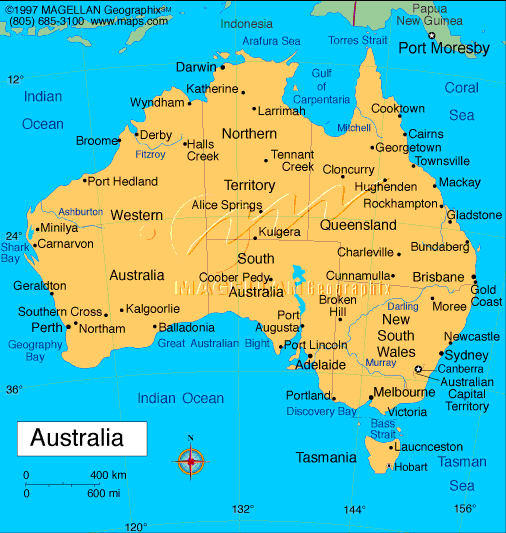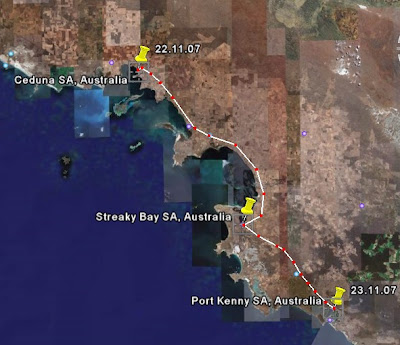 You can see on the aerial view above that the southeastern suburbs of Adelaine end fairly abruptly along a line which coincides with some accentuated relief. It is so marked that I would go as far as to say that the city is hemmed in by the range of hills. These are the Mount Lofty Ranges which separate Adelaide and the Adelaide Plains from the lowlands of the River Murray to the east. And yes, it does look very 'uppy downy' as you can see when you zoom in a little.
You can see on the aerial view above that the southeastern suburbs of Adelaine end fairly abruptly along a line which coincides with some accentuated relief. It is so marked that I would go as far as to say that the city is hemmed in by the range of hills. These are the Mount Lofty Ranges which separate Adelaide and the Adelaide Plains from the lowlands of the River Murray to the east. And yes, it does look very 'uppy downy' as you can see when you zoom in a little. 
The problem with aerial views like this when you want to look at relief is that they flatten the hills. You have to look for clues like the hairpin bends and tunnels to really understand what you are looking at. Clearly, from Mark's description of being two hours in low gear, the road across the Mount Lofty ranges is very steep!
The summit of Mt Lofty provides some pretty good views back down to Adelaide and gives an indication of just how high Mark had to climb today ...  It will be no consolation to Mark that the east side (downhill for him) is much less steep. There is a good geological explanation.....
It will be no consolation to Mark that the east side (downhill for him) is much less steep. There is a good geological explanation.....
The Mount Lofty ranges form the eastern rim of a large syncline (downfold or basin of sedimentary rocks). However, the topography is complicated by the fact that there are also a number of active faults in the Mount Lofty Ranges and these have allowed sections of the crust to slip downhill as in this diagram. It is apparently a very complicated fault zone in which there is still regular minor seismic activity. This type of faulting results in a series of steps in the landscape - downthrown blocks, some with reverse tilt which give the 'switch back' topography described by Mark. And below.... one of those steps .....  It will be no consolation to Mark that the east side (downhill for him) is much less steep. There is a good geological explanation.....
It will be no consolation to Mark that the east side (downhill for him) is much less steep. There is a good geological explanation.....

 It is impossible to write about the 'Geography of Adelaide' in a blog - there's just too much of it!However, if you are so inclined, you can read plenty about the city
It is impossible to write about the 'Geography of Adelaide' in a blog - there's just too much of it!However, if you are so inclined, you can read plenty about the city  You cannot, however, zoom in on the centre of Adelaide without being struck by the layout of the city.... the grid pattern, the rectangular city centre but most of all by the green belt surrounding the CBD. In my experience, this is quite unique - not even rivalled by Central Park in New York .
You cannot, however, zoom in on the centre of Adelaide without being struck by the layout of the city.... the grid pattern, the rectangular city centre but most of all by the green belt surrounding the CBD. In my experience, this is quite unique - not even rivalled by Central Park in New York . 







 The legacy of the industrial history is, however, clearly visible from the air and on the ground....
The legacy of the industrial history is, however, clearly visible from the air and on the ground....



 In fact, if you draw back and look at the area from further 'away' you can clearly see how cultivation in the southern part of the Eyre peninsula gives way to scrubland as you go north...
In fact, if you draw back and look at the area from further 'away' you can clearly see how cultivation in the southern part of the Eyre peninsula gives way to scrubland as you go north...






 By mid afternoon Mark had reached Port Lincoln (where the Google imagery is disappointingly low res) and at that point he was closest to the southern tip of the Eyre peninsula, which an atlas has revealed as 'Cape Catastrophe'. The detail here on Google Earth is stunning and goes a long way to explaining how it came by its name....
By mid afternoon Mark had reached Port Lincoln (where the Google imagery is disappointingly low res) and at that point he was closest to the southern tip of the Eyre peninsula, which an atlas has revealed as 'Cape Catastrophe'. The detail here on Google Earth is stunning and goes a long way to explaining how it came by its name....

 After turning north from Port Lincoln, Mark has been cycling a discordant coastline where the rocks meet the coastline at right angles. Differential erosion (which erodes soft rocks faster than hard ones) produces the capes and bays.
After turning north from Port Lincoln, Mark has been cycling a discordant coastline where the rocks meet the coastline at right angles. Differential erosion (which erodes soft rocks faster than hard ones) produces the capes and bays. 
 After today's cycling, Mark has reached a point about half way down the west coast of the Eyre peninsula. He is cycling on the
After today's cycling, Mark has reached a point about half way down the west coast of the Eyre peninsula. He is cycling on the 



 The similarity in their shapes is not coincidence. The same processes have created coves like these at opposite ends of the world. Both Lulworth and the bay at Elliston have formed on
The similarity in their shapes is not coincidence. The same processes have created coves like these at opposite ends of the world. Both Lulworth and the bay at Elliston have formed on 

 20.42 GMT .... add on the time difference .... Mark is off on his bike already and we haven't even got to bed!!
20.42 GMT .... add on the time difference .... Mark is off on his bike already and we haven't even got to bed!!




 And finally to
And finally to 







 At the end of a day of slightly slacker headwinds than yesterday, Mark reached
At the end of a day of slightly slacker headwinds than yesterday, Mark reached  ...... population 2,300 and according to its website "The town of Ceduna is located on the Far West Coast of South Australia, on the scenic shores of Murat Bay on the Great Australian Bight, approximately 800kms from Adelaide and 1900 road kms to Perth. It is set amidst a patch work of grain farms, natural bush and rugged rocky bays, secluded white sandy beaches and ever changing seas. Far enough away from bustling city life to keep its pristine conditions and solitude, Ceduna and its region offers spectacular beaches bordered by isolated bushland, giving an unspoilt, uncrowded and uniquely different place to live or holiday".
...... population 2,300 and according to its website "The town of Ceduna is located on the Far West Coast of South Australia, on the scenic shores of Murat Bay on the Great Australian Bight, approximately 800kms from Adelaide and 1900 road kms to Perth. It is set amidst a patch work of grain farms, natural bush and rugged rocky bays, secluded white sandy beaches and ever changing seas. Far enough away from bustling city life to keep its pristine conditions and solitude, Ceduna and its region offers spectacular beaches bordered by isolated bushland, giving an unspoilt, uncrowded and uniquely different place to live or holiday".

